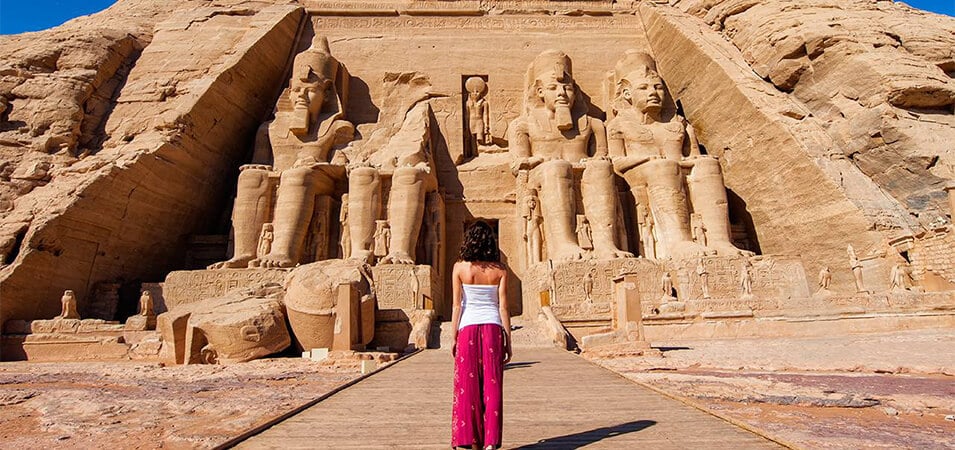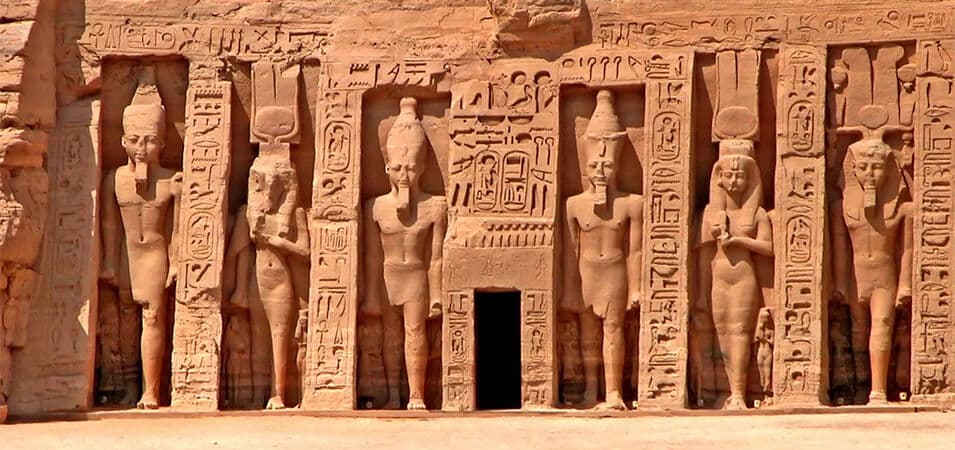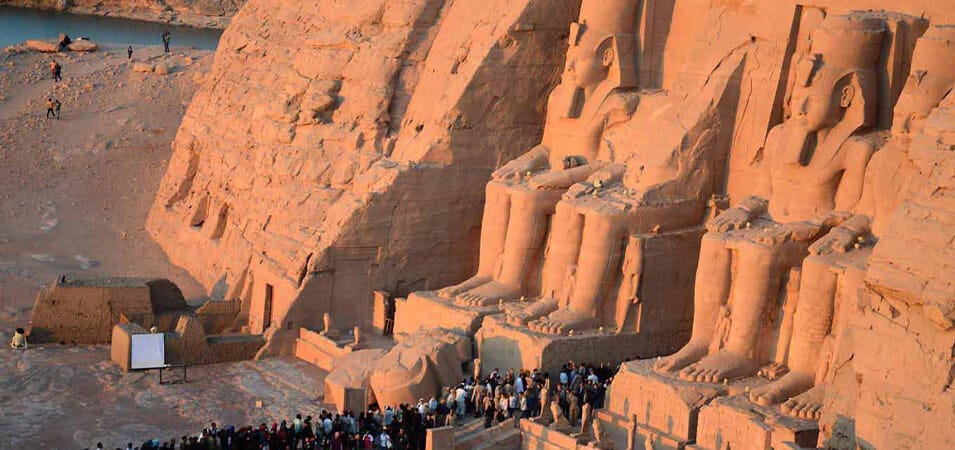The Abu Simbel Temples in the Egyptian city of Aswan are beautiful examples of old Egyptian architecture. During the time of Pharaoh Ramesses II, these buildings were built. They show how grand and artistic the ancient Egyptians were. In this piece, we will talk about the history, architecture, and cultural significance of the Abu Simbel Temples. This will give readers a complete picture of these fantastic buildings.
Don’t Miss checking out our Egypt Tour Packages.
The Great Temple of Abu Simbel
The Great Temple of Abu Simbel is the more significant temple, also called the Temple of Ramses II. This vast structure, carved right into the sandstone hills, amazes people with its size. The front of the temple has four huge figures of Ramses II. Each one is about 20 meters tall and looks like a giant. When you go inside, you will see many halls with intricate relief carvings that show important events from the time of Ramses II.

The History of Abu Simbel Temples
The powerful king Ramses II ordered the construction of the Abu Simbel Temples in the 13th century BCE. They were built to honor Ramses II’s win at the Battle of Kadesh and show his power in religion and politics. The gods Amun, Ra-Horakhty, and Ptah, as well as Ramses II himself, were honored in the shrines.
The Architectural Splendor
The Abu Simbel Temples are works of art and architecture that are very well made. The main temple, the “Great Temple,” has four huge figures of Ramses II sitting on thrones. Each figure is about 66 feet tall and has much detail carved into it. The smaller temple, the Temple of Hathor, is a tribute to Ramses II’s loving wife, Queen Nefertari, and the goddess Hathor.
The Colossal Statues of Ramses II
Abu Simbel is a beautiful place to see the vast figures of Ramses II. These giant statues show the pharaoh as a god, dressed in royal attire and other signs of power. The size and quality of these figures show how good the ancient Egyptians were at building and making sculptures.
The Nubian Monuments Rescue Campaign
In the 1960s, when the Aswan High Dam was being built, the Abu Simbel Temples and other historical sites were in danger. A campaign was started worldwide to move the temples to higher land so they wouldn’t be flooded. The task was a huge job that involved taking the temples apart and putting them back together, block by block.
The Small Temple of Abu Simbel
The Small Temple of Abu Simbel, also called the Temple of Hathor and Nefertari, is next to the Great Temple. Even though it is a smaller size, it is still awe-inspiring. This temple was built to honor Queen Nefertari, Ramses II’s favorite wife, and the goddess Hathor. There are six figures on the front of the building. Four are of Ramses II, and two are of Queen Nefertari. The temple’s colorful wall drawings show how skilled and talented the ancient Egyptians were as artists.
The Relocation of the Temples
In the 1960s, the Abu Simbel Temples were moved in a fantastic feat of engineering. This was done to protect them from the rising water of the Nile caused by the building of the Aswan High Dam. The buildings were taken apart and put back together on higher ground to keep them around for future generations. This fantastic project is an excellent example of new and old engineering methods.

Uncovering the Mysteries of Abu Simbel
The Abu Simbel Temples remain attractive to scholars, archaeologists, and people interested in history. New things are being learned about these ancient wonders through ongoing study and exploration. Recent discoveries have revealed new chambers, secret passageways, and more hieroglyphic writings, helping to figure out what this fantastic site is about.
Exploring the Temples’ Significance in Egyptian Religion
In ancient Egypt’s religion, the churches of Abu Simbel were significant. People thought of them as holy places to talk to the gods. People believed that the practices in the temples would ensure that the pharaoh and his people would be rich, healthy, and live forever. The pharaohs’ divine power and control were shown by how beautiful and symbolic the temple was and how it was built.
Abu Simbel Temples: A Testament to Ancient Egyptian Engineering
For the Abu Simbel Temples to be built, engineers had to use methods ahead of their time. The fact that the ancient Egyptians could carve giant statues and detailed reliefs so precisely into the rock shows how skilled and skilled they were. Even though the temples were moved, their stability is a fantastic feat that shows how well ancient engineering principles were understood.
The Enduring Allure of Abu Simbel Temples
Abu Simbel still makes people feel amazed and interested. Its significant buildings, long history, and beautiful art take people back to the golden age of ancient Egypt. Standing in front of the huge statues, walking through the elaborately decorated halls, and watching the stars line up is a deep and unforgettable look into the past.
The Iconic Facades
The fronts of the temples at Abu Simbel are truly unique. The vast statues at both buildings’ entrances show how powerful and holy Ramses II was. The detailed details, like the pharaoh’s face and the carefully carved hieroglyphics, show how skilled the ancient Egyptians were at making things.
Intricate Interior Design
When people go inside the temples, they are surrounded by the detailed designs of their interiors. Pictures of religious rites, historical events, and gods are on the walls and columns. Hieroglyphic writing tells us a lot about the old Egyptian culture, beliefs, and ways of life.
Visitor Experience
Seeing the Abu Simbel Temples is a unique and special thing to do. Walking in the steps of old pharaohs, you can feel the sense of history and culture. Guided tours give exciting stories about the temples that help to explain their history and solve their riddles. Any traveler will remember seeing the giant statues, colorful wall paintings, and impressive buildings for the rest of their lives.

FAQs to Abu Simple Temples
How were the Abu Simbel Temples relocated?
The Abu Simbel Temples were moved by separating them and putting them back together on higher ground. In the 1960s, this big project was done to protect the temples from the rising water of the Nile.
What is the significance of the Sun Festival?
At Abu Simbel, the Sun Festival happens twice a year when the sun’s rays reach the inner sanctums and light up some figures while leaving others in the dark. This event is a sign of the power of Ra, the sun god, and a celebration of how the sky and earth fit together.
Can I take photographs inside the Abu Simbel Temples?
Photography is usually not allowed inside churches to protect the paintings and carvings on the walls. But photography is permitted in certain places outside the temples so that tourists can take pictures of the beautiful buildings and surroundings.
Conclusion
Visiting the Abu Simbel Temples in Aswan is an extraordinary journey into the heart of ancient Egypt. From the colossal statues and intricate carvings to the vibrant wall paintings and the captivating solar alignment, these temples offer a glimpse into the rich cultural heritage of the pharaohs. The preservation efforts and ongoing research ensure that the legacy of Abu Simbel will continue to inspire awe and fascination for generations to come. Don’t miss the opportunity to witness the magnificence of Abu Simbel Temples. Plan your visit and embark on a remarkable adventure through time and history.
Don’t Miss to Check out our Related Article :
